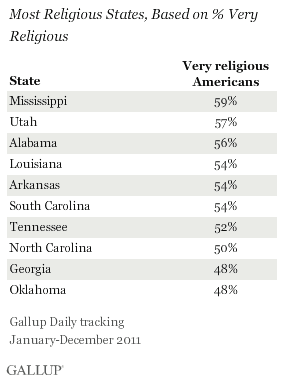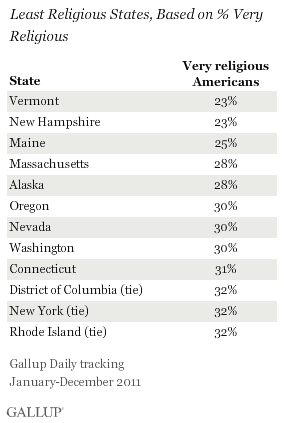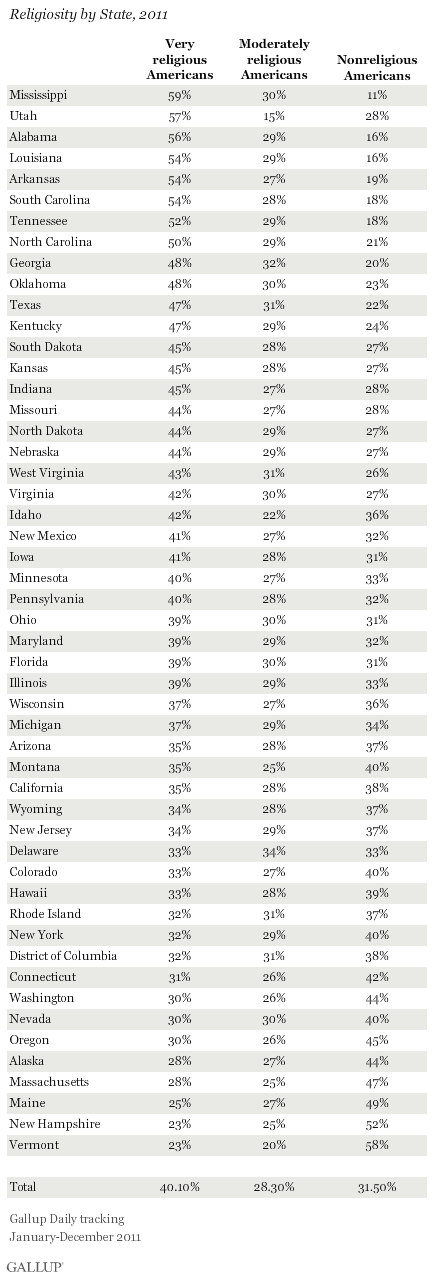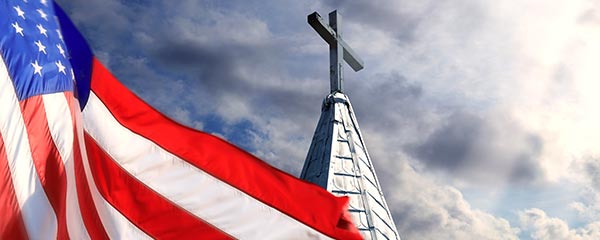PRINCETON, NJ -- Mississippi is the most religious U.S. state, and is one of eight states where Gallup classifies at least half of the residents as "very religious." At the other end of the spectrum, Vermont and New Hampshire are the least religious states, and are two of the five states -- along with Maine, Massachusetts, and Alaska -- where less than 30% of all residents are very religious.


 |
| Explore complete state data |
Religiosity varies widely across U.S. states and regions, with Mississippi in the deep South and Vermont in New England providing the most extreme example of the disparity. Fifty-nine percent of Mississippians are very religious and 11% nonreligious, while 23% of Vermonters are very religious and 58% are nonreligious. Although New Hampshire ties Vermont with 23% of its residents classified as very religious, slightly fewer (52%) residents in the Granite State are classified as nonreligious.
More generally, eight of the 10 most religious states in 2011 are in the South (Mississippi, Alabama, Louisiana, Arkansas, South Carolina, Tennessee, North Carolina, and Georgia), with one straddling the line between the South and the Midwest (Oklahoma), and one in the West (Utah). None of the most religious states are in the Middle Atlantic, New England, or West Coast regions.
By contrast, six of the least religious states in 2011 are in New England (Vermont, New Hampshire, Maine, Massachusetts, Connecticut, and Rhode Island) and four are in the West (Alaska, Oregon, Nevada, and Washington), with the District of Columbia and New York rounding out the list.

These state-by-state patterns in religiousness have remained stable in recent years. Southern states have traditionally been the most religious, and states in New England and in the West have been the least religious.
The complete state-by-state breakdown on this religiosity measure, based on Gallup Daily tracking interviews conducted throughout 2011, appears on page 2.
State Cultures Appear to Influence Religiosity
Gallup research has shown that these state differences appear to be part of a "state culture" phenomenon, and are not the result of differences in the underlying demographics or religious identities in the states. For example, while Mississippi has the highest percentage of blacks of any state in the union, and while blacks are the most religious of any major race or ethnic group in the country, the Magnolia State's white residents are highly religious on a relative basis compared with whites in other states. And, Vermonters who identify as Catholics or with Protestant denominations are less religious than Southern state residents who identify with the same religions. It appears there is something about the culture and normative structure of a state, no doubt based partly on that state's history, that affects its residents' propensity to attend religious services and to declare that religion is important in their daily lives.
Bottom Line
America remains a generally religious nation, with more than two-thirds of the nation's residents classified as very or moderately religious. These overall national averages, however, conceal dramatic regional differences in religiosity across the 50 states and the District of Columbia. Residents of Southern states are generally the most religious, underscoring the validity of the "Bible Belt" sobriquet often used to describe this region. Coupled with the Southern states in the high-religiosity category is Utah, the majority of whose residents are Mormon -- the most religious group in America today. On the other hand, residents of New England and a number of far Western states tend to be the least religious.
Religion is related to politics in today's America, and it is clear from a glance at Gallup's State of the States map that the most religious states in the union generally are the most Republican, while the least religious states skew more toward the Democratic Party. This means that the most divided states -- and thus, those where most of the heavy-duty campaigning in this year's presidential election will be taking place -- are the ones where residents tend to be neither at the very religious nor at the nonreligious end of the spectrum.
Gallup's "State of the States" series reveals state-by-state differences on political, economic, and well-being measures Gallup tracks each day.
Survey Methods
Results are based on telephone interviews conducted as part of the Gallup Daily tracking survey Jan. 1-Dec. 31, 2011, with a random sample of 353,492 adults, aged 18 and older, living in all 50 U.S. states and the District of Columbia.
For results based on the total sample of national adults, one can say with 95% confidence that the maximum margin of sampling error is ±1 percentage point.
Margins of error for individual states are no greater than ±4 percentage points, and are ±3 percentage points in most states.
Interviews are conducted with respondents on landline telephones and cellular phones, with interviews conducted in Spanish for respondents who are primarily Spanish-speaking. Each sample includes a minimum quota of 400 cell phone respondents and 600 landline respondents per 1,000 national adults, with additional minimum quotas among landline respondents by region. Landline telephone numbers are chosen at random among listed telephone numbers. Cell phone numbers are selected using random-digit-dial methods. Landline respondents are chosen at random within each household on the basis of which member had the most recent birthday.
Samples are weighted by gender, age, race, Hispanic ethnicity, education, region, adults in the household, and phone status (cell phone only/landline only/both, cell phone mostly, and having an unlisted landline number). Demographic weighting targets are based on the March 2011 Current Population Survey figures for the aged 18 and older non-institutionalized population living in U.S. telephone households. All reported margins of sampling error include the computed design effects for weighting and sample design.
In addition to sampling error, question wording and practical difficulties in conducting surveys can introduce error or bias into the findings of public opinion polls.
For more details on Gallup's polling methodology, visit www.gallup.com.

